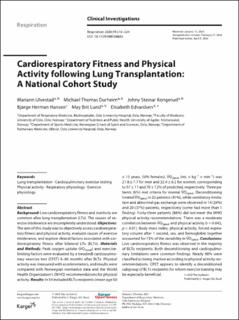| dc.contributor.author | Ulvestad, Mariann | |
| dc.contributor.author | Durheim, Michael Thomas | |
| dc.contributor.author | Kongerud, Johny | |
| dc.contributor.author | Hansen, Bjørge Herman | |
| dc.contributor.author | Samersaw-Lund, May Brit | |
| dc.contributor.author | Edvardsen, Elisabeth | |
| dc.date.accessioned | 2021-03-04T15:44:11Z | |
| dc.date.available | 2021-03-04T15:44:11Z | |
| dc.date.created | 2020-08-21T15:05:26Z | |
| dc.date.issued | 2020 | |
| dc.identifier.citation | Respiration. 2020, 99(4), 316-324. | en_US |
| dc.identifier.issn | 0025-7931 | |
| dc.identifier.uri | https://hdl.handle.net/11250/2731736 | |
| dc.description | This article is licensed under the Creative Commons Attribution-NonCommercial-NoDerivatives 4.0 International License (CC BYNC-ND) (http://www.karger.com/Services/OpenAccessLicense). Usage and distribution for commercial purposes as well as any distribution of modified material requires written permission. | en_US |
| dc.description.abstract | Background: Low cardiorespiratory fitness and inactivity are common after lung transplantation (LTx). The causes of exercise intolerance are incompletely understood.
Objectives: The aim of this study was to objectively assess cardiorespiratory fitness and physical activity, evaluate causes of exercise intolerance, and explore clinical factors associated with cardiorespiratory fitness after bilateral LTx (BLTx).
Materials and Methods: Peak oxygen uptake (V∙O2peak) and exercise-limiting factors were evaluated by a treadmill cardiopulmonary exercise test (CPET) 6–60 months after BLTx. Physical activity was measured with accelerometers, and results were compared with Norwegian normative data and the World Health Organization’s (WHO) recommendations for physical activity.
Results: In 54 included BLTx recipients (mean age 50 ± 15 years, 50% females), V∙O2peak (mL × kg–1 × min–1) was 21.8 ± 7.7 for men and 22.4 ± 6.2 for women, corresponding to 57 ± 17 and 70 ± 12% of predicted, respectively. Three patients (6%) met criteria for normal V∙O2peak. Deconditioning limited V∙O2peak in 22 patients (41%), while ventilatory limitation and abnormal gas exchange were observed in 14 (26%) and 20 (37%) patients, respectively (some had more than 1 finding). Forty-three patients (86%) did not meet the WHO physical activity recommendations. There was a moderate correlation between V∙O2peak and physical activity (r = 0.642, p < 0.01). Body mass index, physical activity, forced expiratory volume after 1 second, sex, and hemoglobin together accounted for 73% of the variability in V∙O2peak.
Conclusions: Low cardiorespiratory fitness was observed in the majority of BLTx recipients. Both deconditioning and cardiopulmonary limitations were common findings. Nearly 90% were classified as being inactive according to physical activity recommendations. CPET appears to identify a deconditioned subgroup of BLTx recipients for whom exercise training may be especially beneficial. | en_US |
| dc.language.iso | eng | en_US |
| dc.subject | lung transplantation | en_US |
| dc.subject | cardiopulmonary exercise testing | en_US |
| dc.subject | physical activity | en_US |
| dc.subject | respiratory physiology | en_US |
| dc.subject | exercise | en_US |
| dc.subject | physiology | en_US |
| dc.title | Cardiorespiratory fitness and physical activity following lung transplantation: A national cohort study | en_US |
| dc.type | Peer reviewed | en_US |
| dc.type | Journal article | en_US |
| dc.description.version | publishedVersion | en_US |
| dc.rights.holder | © 2020 The Author(s) | en_US |
| dc.source.pagenumber | 316-324 | en_US |
| dc.source.volume | 99 | en_US |
| dc.source.journal | Respiration | en_US |
| dc.source.issue | 4 | en_US |
| dc.identifier.doi | 10.1159/000506883 | |
| dc.identifier.cristin | 1824538 | |
| dc.description.localcode | Institutt for idrettsmedisinske fag / Department of Sports Medicine | en_US |
| cristin.ispublished | true | |
| cristin.fulltext | original | |
| cristin.qualitycode | 1 | |
